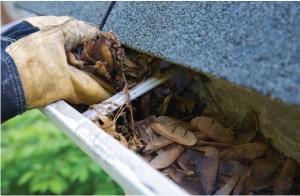Gutters 101: Back to Basics
 By L McK ee
By L McK ee
Why do I need clean gutters?
A clean gutter functions properly by allowing water to flow off the roof, through downspouts, and away from the foundation of a home.
Over time, gutters collect debris. This debris clogs both the gutters and their ownspouts—the vertical channels at either end of the gutters that usher water down and out, away from the home. If either piece is clogged by debris, the proper flow of water may be impossible and may produce disastrous results in the form of various moisture problems. Excess standing water must flow somewhere, so rather than following the suggested path away from the house, it can overflow to various parts of the home’s foundation, causing wet crawl spaces or basements. Excess standing water can also disturb the fascia—the boards onto which the gutters are mounted—and can eventually cause them to rot. Rotten fascia can then lead to moisture damage in the attic space or other places in the home.
Mike Hale of MasterShield Gutter Protection in Roanoke cautions that if your gutters are in desperate need of cleaning, then “damage has already been done.” When the debris in your gutters gets wet, it can weigh them down and cause them to pull away or become unlevel. Standing water can attract mosquitoes and other kinds of pests too. In short, gutters should be free of water and debris to avoid a host of moisture-related problems.
How often should I clean the gutters?
Gutter maintenance isn’t on a one-size-fits-all schedule like other home chores. “It depends on the trees around the house,” says Richie Kahlich of Sentry Exteriors, an exterior home maintenance company with locations in Lynchburg, Roanoke and Charlottesville. “On average, most people tend to clean between two and four times a year. A lot of times people do it in the spring when the buds start falling, and then in the fall when the leaves are falling,” he explains. As the number of trees on every piece of property differs, so does the influx of water and debris to gutters. A homeowner with only a few trees would need to clean the gutters less often than a homeowner living on a
wooded lot.
Should I clean the gutters myself or hire a professional?
According to Ryan Boitnott of Virginia Gutter, Inc., “Any homeowner that’s able to get on a ladder is able to clean out a gutter.” But the real question is: what is your comfort level climbing on a ladder to the top of your home? Wrestling debris out of the gutters while perched many feet off the ground can be challenging. If this seems daunting, the best choice for completing routine gutter care would be to consult
a professional. However, homeowners who feel comfortable using and working from a ladder, may choose the do-it-yourself option. If you take on this task, consider these materials and basic steps.
Materials
- Sturdy ladder
- Work gloves
- Safety goggles
- Bucket for collecting debris
- Water hose
Steps to Take—With Caution
- Set up a sturdy ladder that rests on or just below the gutters.
- Wearing gloves and goggles, climb the ladder while carrying the bucket to collect debris.
- Starting at one end of the structure by a downspout, and focusing on the section of gutter within reach, carefully collect the debris into the bucket.
- Repeat this process as needed around remaining perimeter of the home.
- Starting away from the downspout, use a hose to spray remaining debris toward the downspout. Finally, spray through downspout to rid the pipe of any clogs.
Should I repair or replace?
Though there is no specific lifespan for gutters, damage or agerelated problems will help you decide to repair or replace the
system. Over time, a common problem is that gutters pull away from the home. According to Kahlich, “A lot of gutters pull away
due to the spikes and ferrells that work themselves out over the years. To fix this, we use a hidden hanger that goes inside the
gutter with wood screws.” In addition, water leaks may begin to surface over time due to aging gutters. Though the cause of
any given leak can often be identified and fixed, a homeowner may decide that extensive leakage warrants investigation of an
entirely new gutter system. You can choose from traditional gutters, and maintenance-free gutter systems.
Hale of MasterShield Gutter Protection explains the concept of maintenance-free gutter systems—systems which aim to whisk water away and keep leaves and debris out. Most of these systems are based upon “reverse curve” technology—a cover for the gutters that was originally patented over 100 years ago. Hale says that the product he sells—MasterShield—is also maintenance-free but relies on new technology that filters water through a micromesh membrane. This membrane keeps debris out while creating a “vortex” of suction that draws water into the gutter no matter how steep the roof or strong the downpour. Such systems can be added to existing gutters.
“On average, most people tend to clean between two and four times a year. A lot of times people do it in the spring when the buds start falling, and then in the fall when the leaves are falling.”—Richie Kahlich, Sentry Exteriors Virginia Gutter, Inc.
Sentry’s Kahlich gives this advice: “There are gutters available that really do work. Do good research and find them.” On average, prices start around $800 to $1,000 to replace a traditional gutter system. Prices are based on linear footage and therefore vary from home to home.
Gutter care is only one small aspect of being a homeowner, but can lead to significant problems if neglected. With a little planning andassessment, routine gutter maintenance can keep your home in top shape for years to come.






